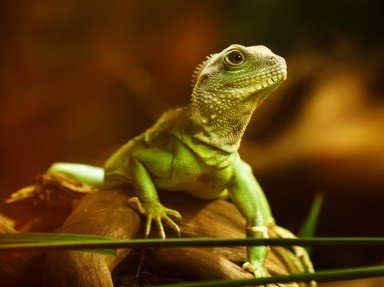Quiz Answer Key and Fun Facts
1. The armadillo girdled lizard, also known as the golden-armadillo lizard, grabs its tail with its mouth and rolls into a ball when frightened. For this reason, its genus name is derived from what ancient symbol depicting a serpent eating its own tail?
2. The thorny devil, or Moloch, lives in the deserts of Australia. What does this fierce looking creature eat?
3. Despite the Gila monster's fearsome reputation as a poisonous lizard, its venom is so weak that a bite from one is unlikely to cause a healthy adult more than mild discomfort.
4. The frilled lizard, one of Australia's most distinctive lizards, primarily lives in what habitat?
5. The rhinoceros iguana, so-named for the bony protrusions on its snout, is an endangered species found on what Caribbean island that is shared by two different countries?
6. Blue-tongued lizards are the largest members of the skink family, and like other skinks can drop their tail when threatened to help them escape from predators.
7. Jackson's horned chameleon is native to which region of the world?
8. The horny toad or, more accurately, horned lizard, has what unusual defence mechanism that it uses to good effect against canine and feline predators?
9. The marine iguana is unique among modern lizards in obtaining all of its food from the sea. It is found on which island group, where it attracted the attention of famed naturalist Charles Darwin?
10. Komodo dragons, as well as being the world's largest living lizard, have an unusual alternative mode of reproduction. During mating season, if there are no males available, female Komodo dragons can reproduce asexually through a process known as what?
Source: Author
agentofchaos
This quiz was reviewed by FunTrivia editor
rossian before going online.
Any errors found in FunTrivia content are routinely corrected through our feedback system.

